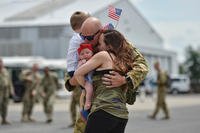Communications play a critical role when a servicemember is physically absent. Maintaining an emotional connection is essential in sustaining a relationship. Active communication also boosts morale for both the servicemember and those left at home. It is vital to make communication plans prior to the period of separation to avoid misunderstandings and to save on those unexpected long distance phone calls! Consider which of these methods might be best for your family.
Letters: Letters are the most inexpensive way of communicating and can be the most satisfying. Letters can be reread over and over, especially during periods of loneliness. They are also fun to read years later! Letters can be long, detailed accounts of everyday activities or can be short and sweet "thinking of you" messages. Whatever the style, letters are much appreciated by both partners. It is imperative that you date each letter as you may not receive letters in sequential order. Some couples number every letter that they send so the receiving partner knows which one to read first when he or she receives five letters in one day (mail service on and off ships is sometimes unpredictable!).
E-mail: Communicating via e-mail has become increasingly popular for geographically separated couples. However, the servicemember will need to check for system availability aboard ship or at his or her destination. If a computer and e-mail account are made available, this is an excellent way of communicating. This mode of communication is fairly fast and each partner can get "up-to-date" information. If time, planning, and capability exist the couple can create a private chat room and have an electronic conversation. If the spouse at home does not have a personal computer or Internet service, he or she can check at a nearby military installation or another family readiness agency which may offer e-mail access. If this is not convenient, check with your local library for Internet access and free e-mail accounts.
Phone: Relying solely on telephonic communication can be extremely expensive. Many a spouse has gasped with disbelief when the phone bill arrives, so beware! However, hearing your loved ones voice every now and then is a luxury that many couples will budget for. Compare prices between a direct phone call and paying with a phone card. A pre-paid phone card is convenient and there are no surprise bills. Also, check with your long distance carrier for military overseas discounts. Most of the major phone companies offer such discounts. You will need to open this account prior to the separation. Consider using a MARS (Military Affiliated Radio System) station if one is conveniently located near you. The MARS operators are HAM radio owners who have volunteered to help bring military families together. They are patching the call from the ship and will be on the line with you. Calls are limited to 3 to 5 minutes. This service is free of charge.
Care Packages: Care packages send a little piece of home to the servicemember. Things to include might be photographs, cookies, magazines, or a home video. Delivery usually takes 2 to 3 weeks but can take as long as 6 to 8 weeks so send early if you want it to arrive in time for a special occasion. You will need to follow postal regulations for packing and wrapping. Care packages are wonderful morale boosters during a deployment.
Audio/Videotapes: Audiotapes are an excellent way to hear the voice of your loved one. You can give a long, detailed account of the day or week, or you can add a little bit each day. This will take prior planning as you both will need a tape player/recorder. Videos are an excellent resource for loved ones to see where the servicemember is stationed or what the sea and ship look like. Likewise, the servicemember will enjoy seeing his or her family engaging in activities. Again, prior planning is essential. You may want to share resources with other families so both the servicemember and the family members have access to a recorder. Some units offer a taping session for families to be viewed by the service members aboard ship.
Telegram: If speed is needed, a non-emergency message can be sent via Western Union. Messages are usually delivered within 36 hours. Just remember that many people will see this message so do not include private information.




















